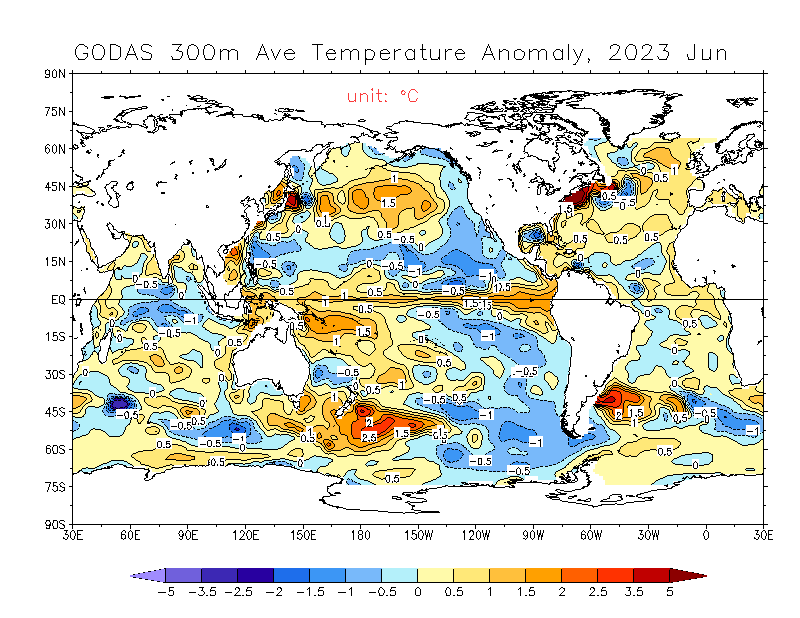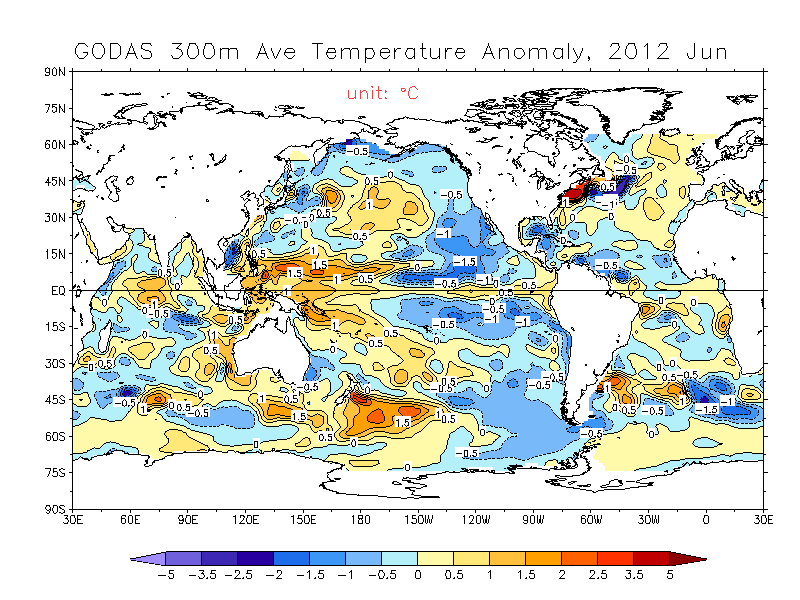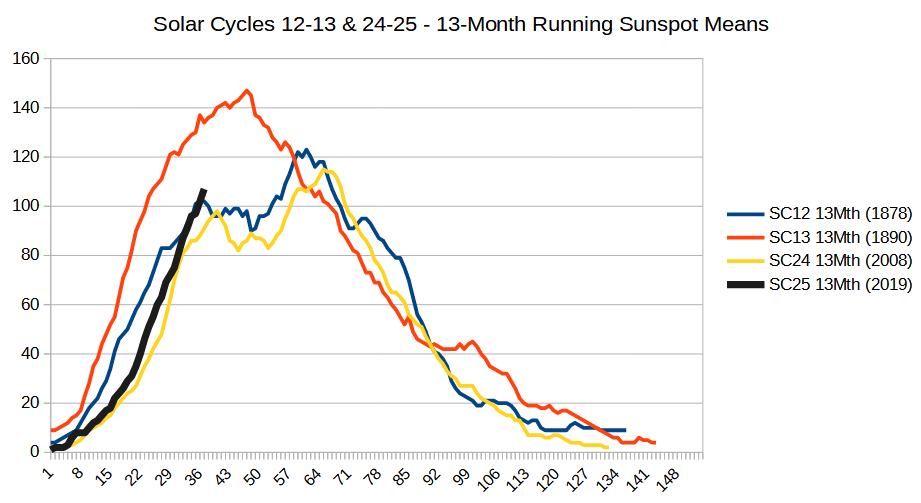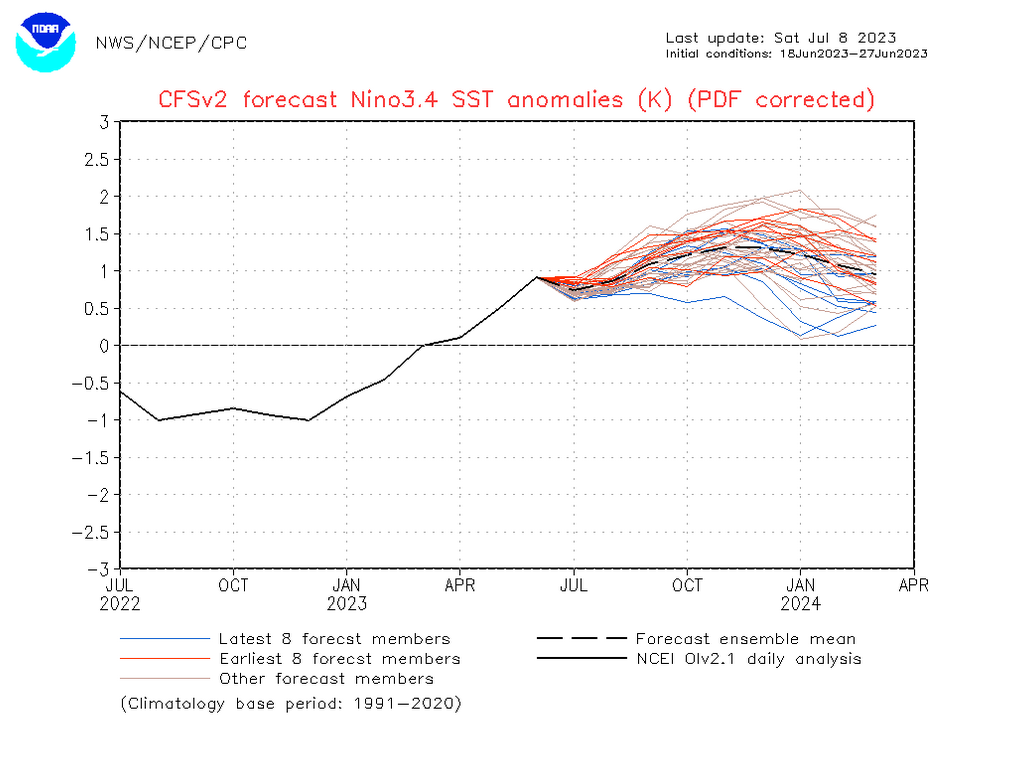|
|
Post by missouriboy on Jul 6, 2023 17:04:38 GMT
Back to GODAS for June 2023. Note that the bulk of the equatorial West Pacific upper ocean heat is south of the equator (Map left). Compare that to June 2012 ... same spot on solar cycle 24 (Map right). Sure looks like a heat drift to the south.   |
|
|
|
Post by douglavers on Jul 7, 2023 0:40:26 GMT
www.longpaddock.qld.gov.au/soi/SOI seems to be stabilising in solidly positive territory. Adios El Nino? With the trade winds presumably picking up, cold will be starting to stream across Equatorial Pacific again.
|
|
|
|
Post by code on Jul 7, 2023 1:35:32 GMT
www.longpaddock.qld.gov.au/soi/SOI seems to be stabilising in solidly positive territory. Adios El Nino? With the trade winds presumably picking up, cold will be starting to stream across Equatorial Pacific again.  Say more please? |
|
|
|
Post by douglavers on Jul 7, 2023 7:49:48 GMT
www.longpaddock.qld.gov.au/soi/SOI seems to be stabilising in solidly positive territory. Adios El Nino? With the trade winds presumably picking up, cold will be starting to stream across Equatorial Pacific again.  Say more please? I think the way El Nino works, is that the trade winds weaken allowing "piled up" warm water in the region East of Indonesia/PNG to flow back Eastwards. .
When the trade winds pick up, warmish water is blown back westwards, allowing cool deep water to the surface. |
|
|
|
Post by walnut on Jul 7, 2023 12:52:15 GMT
 Say more please? I think the way El Nino works, is that the trade winds weaken allowing "piled up" warm water in the region East of Indonesia/PNG to flow back Eastwards. .
When the trade winds pick up, warmish water is blown back westwards, allowing cool deep water to the surface.Apparently it doesn't help the surfing conditions on your eastern coast. Sorry www.scienceofthesurf.com/blogs-2022/blog-post-title-one-fcnnf#:~:text=A%20La%20Nina%20cycle%20occurs,the%20western%20Pacific%20–%20that%27s%20us! |
|
|
|
Post by missouriboy on Jul 7, 2023 17:24:24 GMT
www.longpaddock.qld.gov.au/soi/SOI seems to be stabilising in solidly positive territory. Adios El Nino? With the trade winds presumably picking up, cold will be starting to stream across Equatorial Pacific again. Notice the solar-cycle Nino-Region 3.4 and 4 trends for solar cycles 19 and 20 ... the strange strong cycle SC19 with no pre-cycle nino and the equally strange weak cycle SC20 with the deepest and coldest La Ninas (in its tail) in our whole record (since 1950). Both of them rose to very weak and short El Nino highs within 12 months of where we are now, then dropped into La Nina territory for most of the rest of their cycle. There were a series of very cold winters in the tail-end of SC20. Scared the climate science community into predicting a new Ice Age  . And they got burned.  We should see across the next 12 months how SC25 is going to trend. It may be turning over now? If SC25 were to imitate SC20, the winters of 2025-26 and/or 2026-27 could be exciting. If this this is a 1-peak solar cycle,  |
|
|
|
Post by missouriboy on Jul 7, 2023 17:36:48 GMT
Looking through the solar cycle sunspot progressions, Our current two low-cycle progression looks very much like Solar cycles 12 and 13. More so than any past 2-cycle combo. Cycle 24 was almost a mirror image of Cycle 12. We don't have detailed multi-zone ENSO values older than 1950. If the sun is A (one) primary driver of ENSO and ENSO is a primary driver of lower Troposphere temperatures, then the next three years or so should be very instructive. SC24 will likely not be as high as SC13, which was a one-peak cycle.  |
|
|
|
Post by ratty on Jul 8, 2023 0:16:40 GMT
Looking through the solar cycle sunspot progressions, Our current two low-cycle progression looks very much like Solar cycles 12 and 13. More so than any past 2-cycle combo. Cycle 24 was almost a mirror image of Cycle 12. We don't have detailed multi-zone ENSO values older than 1950. If the sun is A (one) primary driver of ENSO and ENSO is a primary driver of lower Troposphere temperatures, then the next three years or so should be very instructive. SC24 will likely not be as high as SC13, which was a one-peak cycle. |
|
|
|
Post by missouriboy on Jul 8, 2023 2:46:34 GMT
Looking through the solar cycle sunspot progressions, Our current two low-cycle progression looks very much like Solar cycles 12 and 13. More so than any past 2-cycle combo. Cycle 24 was almost a mirror image of Cycle 12. We don't have detailed multi-zone ENSO values older than 1950. If the sun is A (one) primary driver of ENSO and ENSO is a primary driver of lower Troposphere temperatures, then the next three years or so should be very instructive. SC24 will likely not be as high as SC13, which was a one-peak cycle.I meant SC25.  I'll have to load Cindy as a proof reader. |
|
|
|
Post by ratty on Jul 8, 2023 3:48:55 GMT
I meant SC25.  I'll have to load Cindy as a proof reader. For a small fee, I could help .....  Shall I fix it for you? |
|
|
|
Post by missouriboy on Jul 8, 2023 4:29:41 GMT
I meant SC25.  I'll have to load Cindy as a proof reader. For a small fee, I could help .....  Shall I fix it for you? What do you mean by "fix"?  |
|
|
|
Post by nonentropic on Jul 8, 2023 6:48:34 GMT
"fix" is not word you use loosely.
|
|
|
|
Post by ratty on Jul 8, 2023 7:39:18 GMT
"fix" is not word you use loosely. I would use Mike's nature trick. |
|
|
|
Post by missouriboy on Jul 8, 2023 15:24:25 GMT
"fix" is not word you use loosely. I would use Mike's nature trick. Quoi? I'm practicing my very poor French. |
|
|
|
Post by duwayne on Jul 8, 2023 18:36:35 GMT
Here’s the latest (May 19,2023) NOAA ENSO prediction using their so-called “state-of-the-art” model.
I wanted to get this on the record so we can look back at the end of 2023 and see how accurate their Dynamic model was.
So a month and a half ago, the "state-of-the-art" NOAA "Forecast ensemble mean" above was predicting ENSO to climb to 2.0 before year's end. Now the revised peak prediction (see below) is down to about 1.3.
Could anyone ever have suspected the models were running way too hot? Yes.
Could it be possible they are still way too hot? I think so.

|
|